Experimental Investigation on Waste Heat Recovery from a Cement Factory to Enhance Thermoelectric Generation
Abstract
:1. Introduction
2. Experiment Setup
2.1. Location
2.2. Thermoelectric Devices
2.3. Cooling Systems
2.3.1. Forced-Air Cooling Method
2.3.2. Active-Water Cooling Method
2.4. Monitoring System
3. Results and Discussion
3.1. TEG Performance
3.2. TEG Saving and Payback Period
3.3. Work Validation
4. Conclusions
Author Contributions
Funding
Institutional Review Board Statement
Informed Consent Statement
Data Availability Statement
Conflicts of Interest
Appendix A

| Item | Unit | Value |
|---|---|---|
| Hot-side temperature | °C | 320 |
| Cold-side temperature | °C | 30 |
| Open circuit voltage (DC) | V | 17.7 |
| Heat flow density | W/cm2 | ≈9.6 |
| AC resistance (ohms) measured under 27 at 1000 Hz | °C | 2.3–2.5 |
| Electrical resistivity (ρ) | mΩ/m | 1.2 |
| Thermal conductivity (k) | W/m·K | 1.75 |
| Figure of merit (ZT) | (-) | >1 |
| Seebeck coefficient (α) | μV/K | 210 |
| Device Name | Measuring Range | Accuracy | Photo of Device |
|---|---|---|---|
| Pt 100 DS18B20 | −55 °C to +125 °C | ±0.5 °C |  |
| Thermocouple Max6675 | 0 °C to + 1024 °C | ±0.25 °C |  |
| Thermal image camera Fluke Ti100 | −20 °C to +250 °C | ±0.1 °C |  |
| Infrared Testo 835-T2 | −10 °C to +1500 °C | ±0.01 °C | 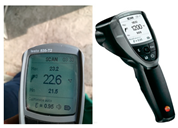 |
| Weather conditions (1. Temperature and 2. wind speed sensors) | −40°C–60 °C 0–50 m/s (0~100 mph) | 0.1 °C +/−0.25 m/s |  |
References
- Gomaa, M.R.; Al-Dmour, N.; AL-Rawashdeh, H.A.; Shalby, M. Theoretical Model of a Fluidized Bed Solar Reactor Design with the Aid of MCRT Method and Synthesis Gas Production. Renew. Energy 2020, 148, 91–102. [Google Scholar] [CrossRef]
- Gomaa, M.R.; Mustafa, R.J.; Al-Dmour, N. Solar Thermochemical Conversion of Carbonaceous Materials into Syngas by Co-Gasification. J. Clean. Prod. 2020, 248, 119185. [Google Scholar] [CrossRef]
- Marashli, A.; Alfanatseh, E.; Shalby, M.; Gomaa, M.R. Modelling Single-Effect of Lithium Bromide-Water (LiBr–H2O) Driven by an Evacuated Solar Tube Collector in Ma’an City (Jordan) Case Study. Case Stud. Therm. Eng. 2022, 37, 102239. [Google Scholar] [CrossRef]
- Gomaa, M.R.; Mustafa, R.J.; Al-Dhaifallah, M.; Rezk, H. A Low-Grade Heat Organic Rankine Cycle Driven by Hybrid Solar Collectors and a Waste Heat Recovery System. Energy Rep. 2020, 6, 3425–3445. [Google Scholar] [CrossRef]
- Al-Rawashdeh, H.A.; Gomaa, M.R.; Mustafa, R.J.; Hasan, A.O. Efficiency and Exergy Enhancement of ORC Powered by Recovering Flue Gases-Heat System in Cement Industrials: A Case Study. Int. Rev. Mech. Eng. 2019, 13, 185–197. [Google Scholar] [CrossRef]
- Arzbaecher, C.; Parmenter, K.; Fouche, E. Industrial Waste-Heat Recovery: Benefits and Recent Advancements in Technology and Applications. In Proceedings of the ACEEE, Denver, CO, USA, 15–18 August 2007; pp. 1–2. [Google Scholar]
- Ayu, T.T.; Hailu, M.H.; Hagos, F.Y.; Atnaw, S.M. Energy Audit and Waste Heat Recovery System Design for a Cement Rotary Kiln in Ethiopia: A Case Study. Int. J. Automot. Mech. Eng. 2015, 12, 2983–3002. [Google Scholar] [CrossRef]
- Lee, H.S. Thermoelectrics: Design and Materials; Wiley: Hoboken, NJ, USA, 2016; ISBN 9781118848944. [Google Scholar]
- Gomaa, M.R.; Rezk, H. Passive Cooling System for Enhancement the Energy Conversion Efficiency of Thermo-Electric Generator. Energy Rep. 2020, 6, 687–692. [Google Scholar] [CrossRef]
- Rosa, O.C. Designing a Thermoelectric Energy Generator for Waste Heat Recovery in Heavy-Duty Diesel Engines. 2017, p. 138. Available online: https://repositorio.ufsc.br/handle/123456789/182599 (accessed on 23 March 2021).
- Kanagaraj, N.; Rezk, H.; Gomaa, M.R. A Variable Fractional Order Fuzzy Logic Control Based Mppt Technique for Improving Energy Conversion Efficiency of Thermoelectric Power Generator. Energies 2020, 13, 4531. [Google Scholar] [CrossRef]
- Wu, Q.; Hu, J. A Novel Design for a Wearable Thermoelectric Generator Based on 3D Fabric Structure. Smart Mater. Struct. 2017, 26, 045037. [Google Scholar] [CrossRef]
- Jung, Y.S.; Jeong, D.H.; Kang, S.B.; Kim, F.; Jeong, M.H.; Lee, K.S.; Son, J.S.; Baik, J.M.; Kim, J.S.; Choi, K.J. Wearable Solar Thermoelectric Generator Driven by Unprecedentedly High Temperature Difference. Nano Energy 2017, 40, 663–672. [Google Scholar] [CrossRef]
- Lu, Z.; Zhang, H.; Mao, C.; Li, C.M. Silk Fabric-Based Wearable Thermoelectric Generator for Energy Harvesting from the Human Body. Appl. Energy 2016, 164, 57–63. [Google Scholar] [CrossRef]
- Meng, J.H.; Wang, X.D.; Chen, W.H. Performance Investigation and Design Optimization of a Thermoelectric Generator Applied in Automobile Exhaust Waste Heat Recovery. Energy Convers. Manag. 2016, 120, 71–80. [Google Scholar] [CrossRef]
- Lan, S.; Yang, Z.; Chen, R.; Stobart, R. A Dynamic Model for Thermoelectric Generator Applied to Vehicle Waste Heat Recovery. Appl. Energy 2018, 210, 327–338. [Google Scholar] [CrossRef]
- Demir, M.E.; Dincer, I. Performance Assessment of a Thermoelectric Generator Applied to Exhaust Waste Heat Recovery. Appl. Therm. Eng. 2017, 120, 694–707. [Google Scholar] [CrossRef]
- Mahmoudinezhad, S.; Rezania, A.; Rosendahl, L.A. Behavior of Hybrid Concentrated Photovoltaic-Thermoelectric Generator under Variable Solar Radiation. Energy Convers. Manag. 2018, 164, 443–452. [Google Scholar] [CrossRef]
- Rezk, H.; Ali, Z.M.; Abdalla, O.; Younis, O.; Gomaa, M.R.; Hashim, M. Hybrid Moth-Flame Optimization Algorithm and Incremental Conductance for Tracking Maximum Power of Solar PV/Thermoelectric System under Different Conditions. Mathematics 2019, 7, 875. [Google Scholar] [CrossRef]
- Islam, S.; Dincer, I.; Yilbas, B.S. Development, Analysis and Assessment of Solar Energy-Based Multigeneration System with Thermoelectric Generator. Energy Convers. Manag. 2018, 156, 746–756. [Google Scholar] [CrossRef]
- Meng, F.; Chen, L.; Feng, Y.; Xiong, B. Thermoelectric Generator for Industrial Gas Phase Waste Heat Recovery. Energy 2017, 135, 83–90. [Google Scholar] [CrossRef]
- Li, G.; Zhang, G.; He, W.; Ji, J.; Lv, S.; Chen, X.; Chen, H. Performance Analysis on a Solar Concentrating Thermoelectric Generator Using the Micro-Channel Heat Pipe Array. Energy Convers. Manag. 2016, 112, 191–198. [Google Scholar] [CrossRef]
- Ziapour, B.M.; Saadat, M.; Palideh, V.; Afzal, S. Power Generation Enhancement in a Salinity-Gradient Solar Pond Power Plant Using Thermoelectric Generator. Energy Convers. Manag. 2017, 136, 283–293. [Google Scholar] [CrossRef]
- Hsu, C.T.; Won, C.C.; Chu, H.S.; Hwang, J.D. A Case Study of Thermoelectric Generator Application on Rotary Cement Furnace. In Proceedings of the Technical Papers—International Microsystems, Packaging, Assembly, and Circuits Technology Conference, IMPACT, Taipei, Taiwan, 22–25 October 2013; pp. 78–81. [Google Scholar]
- Luo, Q.; Li, P.; Cai, L.; Zhou, P.; Tang, D.; Zhai, P.; Zhang, Q. A Thermoelectric Waste-Heat-Recovery System for Portland Cement Rotary Kilns. J. Electron. Mater. 2015, 44, 1750–1762. [Google Scholar] [CrossRef]
- Sajid, M.; Hassan, I.; Rahman, A. An Overview of Cooling of Thermoelectric Devices. Renew. Sustain. Energy Rev. 2017, 78, 15–22. [Google Scholar] [CrossRef]
- Wu, W.N.; Liu, X.Y.; Hu, Z.; Zhang, R.; Lu, X.Y. Improving the Sustainability of Cement Clinker Calcination Process by Assessing the Heat Loss through Kiln Shell and Its Influencing Factors: A Case Study in China. J. Clean. Prod. 2019, 224, 132–141. [Google Scholar] [CrossRef]
- Mirhosseini, M.; Rezania, A.; Rosendahl, L. Power Optimization and Economic Evaluation of Thermoelectric Waste Heat Recovery System around a Rotary Cement Kiln. J. Clean. Prod. 2019, 232, 1321–1334. [Google Scholar] [CrossRef]
- Mirhosseini, M.; Rezania, A.; Rosendahl, L. Harvesting Waste Heat from Cement Kiln Shell by Thermoelectric System. Energy 2019, 168, 358–369. [Google Scholar] [CrossRef]
- Fan, S.; Gao, Y. Numerical Analysis on the Segmented Annular Thermoelectric Generator for Waste Heat Recovery. Energy 2019, 183, 35–47. [Google Scholar] [CrossRef]
- Deolalkar, S.P. Handbook for Designing Cement Plants; BS Publications: Telangana, India, 2021; ISBN 81-7800-145-4. [Google Scholar]
- Holderbank, Inc. Heat Balance of Kiln and Coolers and Related Topics. Cement Seminar: Comminution Engineering, Process Technology. 1993. Available online: https://pdfcoffee.com/heat-balance-of-kilns-and-coolers-and-related-topics-pdf-free.html (accessed on 24 May 2022).
- Enescu, D.; Virjoghe, E.O. A Review on Thermoelectric Cooling Parameters and Performance. Renew. Sustain. Energy Rev. 2014, 38, 903–916. [Google Scholar] [CrossRef]
- Rowe, D.; Raton London New York, B. Thermoelectrics Handbook; CRC Press: Boca Raton, FL, USA, 2018; ISBN 9781315220390. [Google Scholar]
- Li, Y.; Wang, S.; Zhao, Y.; Lu, C. Experimental Study on the Influence of Porous Foam Metal Filled in the Core Flow Region on the Performance of Thermoelectric Generators. Appl. Energy 2017, 207, 634–642. [Google Scholar] [CrossRef]
- Kim, T.Y.; Kwak, J.; Kim, B. wook Energy Harvesting Performance of Hexagonal Shaped Thermoelectric Generator for Passenger Vehicle Applications: An Experimental Approach. Energy Convers. Manag. 2018, 160, 14–21. [Google Scholar] [CrossRef]
- Kim, T.Y.; Kwak, J.; Kim, B. wook Application of Compact Thermoelectric Generator to Hybrid Electric Vehicle Engine Operating under Real Vehicle Operating Conditions. Energy Convers. Manag. 2019, 201, 112150. [Google Scholar] [CrossRef]
- Kempf, N.; Zhang, Y. Design and Optimization of Automotive Thermoelectric Generators for Maximum Fuel Efficiency Improvement. Energy Convers. Manag. 2016, 121, 224–231. [Google Scholar] [CrossRef]
- Kim, T.Y.; Negash, A.A.; Cho, G. Experimental Study of Energy Utilization Effectiveness of Thermoelectric Generator on Diesel Engine. Energy 2017, 128, 531–539. [Google Scholar] [CrossRef]
- Vale, S.; Heber, L.; Coelho, P.J.; Silva, C.M. Parametric Study of a Thermoelectric Generator System for Exhaust Gas Energy Recovery in Diesel Road Freight Transportation. Energy Convers. Manag. 2017, 133, 167–177. [Google Scholar] [CrossRef]
- Zhao, Y.; Wang, S.; Ge, M.; Liang, Z.; Liang, Y.; Li, Y. Performance Investigation of an Intermediate Fluid Thermoelectric Generator for Automobile Exhaust Waste Heat Recovery. Appl. Energy 2019, 239, 425–433. [Google Scholar] [CrossRef]
- Li, B.; Huang, K.; Yan, Y.; Li, Y.; Twaha, S.; Zhu, J. Heat Transfer Enhancement of a Modularised Thermoelectric Power Generator for Passenger Vehicles. Appl. Energy 2017, 205, 868–879. [Google Scholar] [CrossRef]
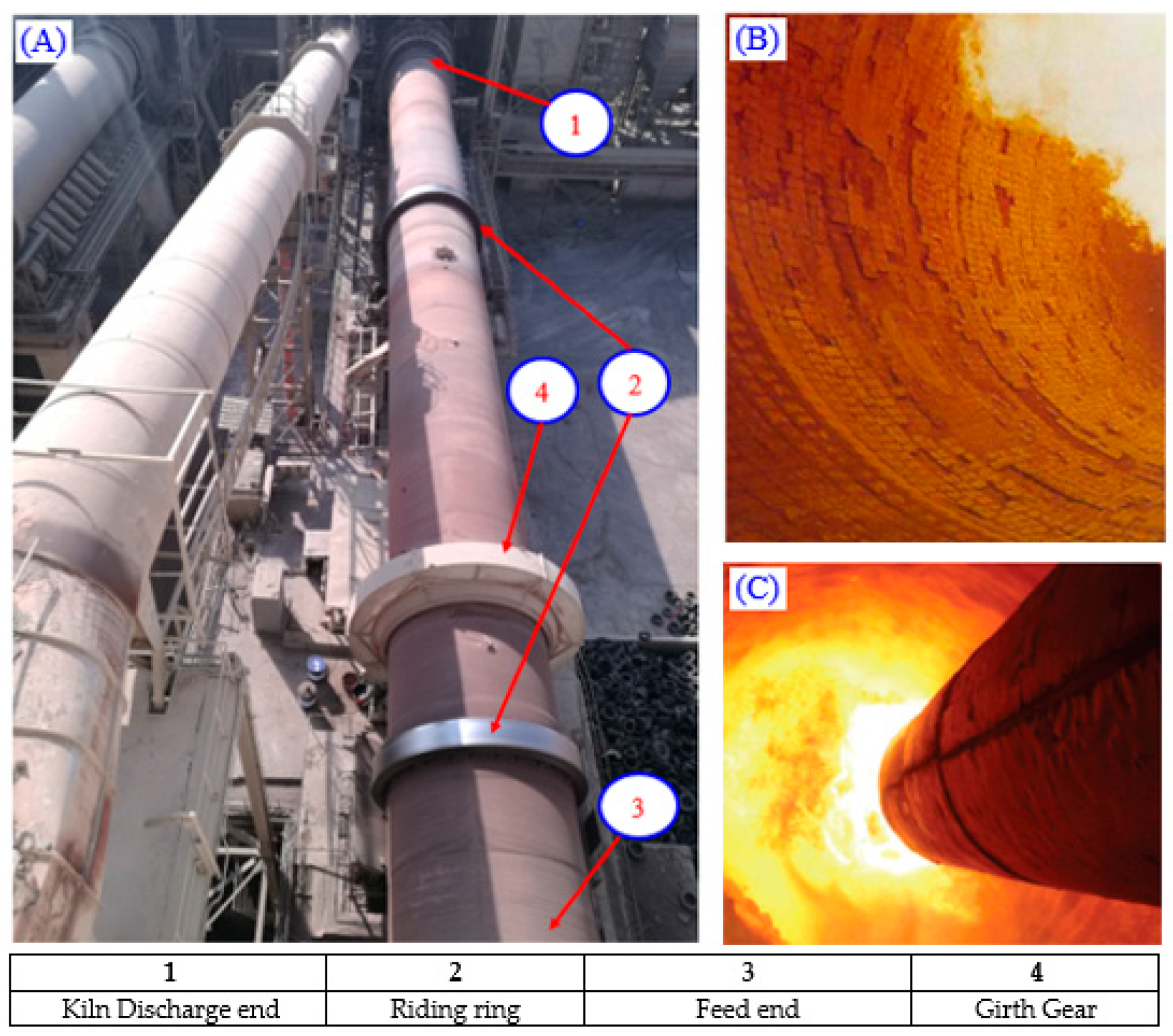
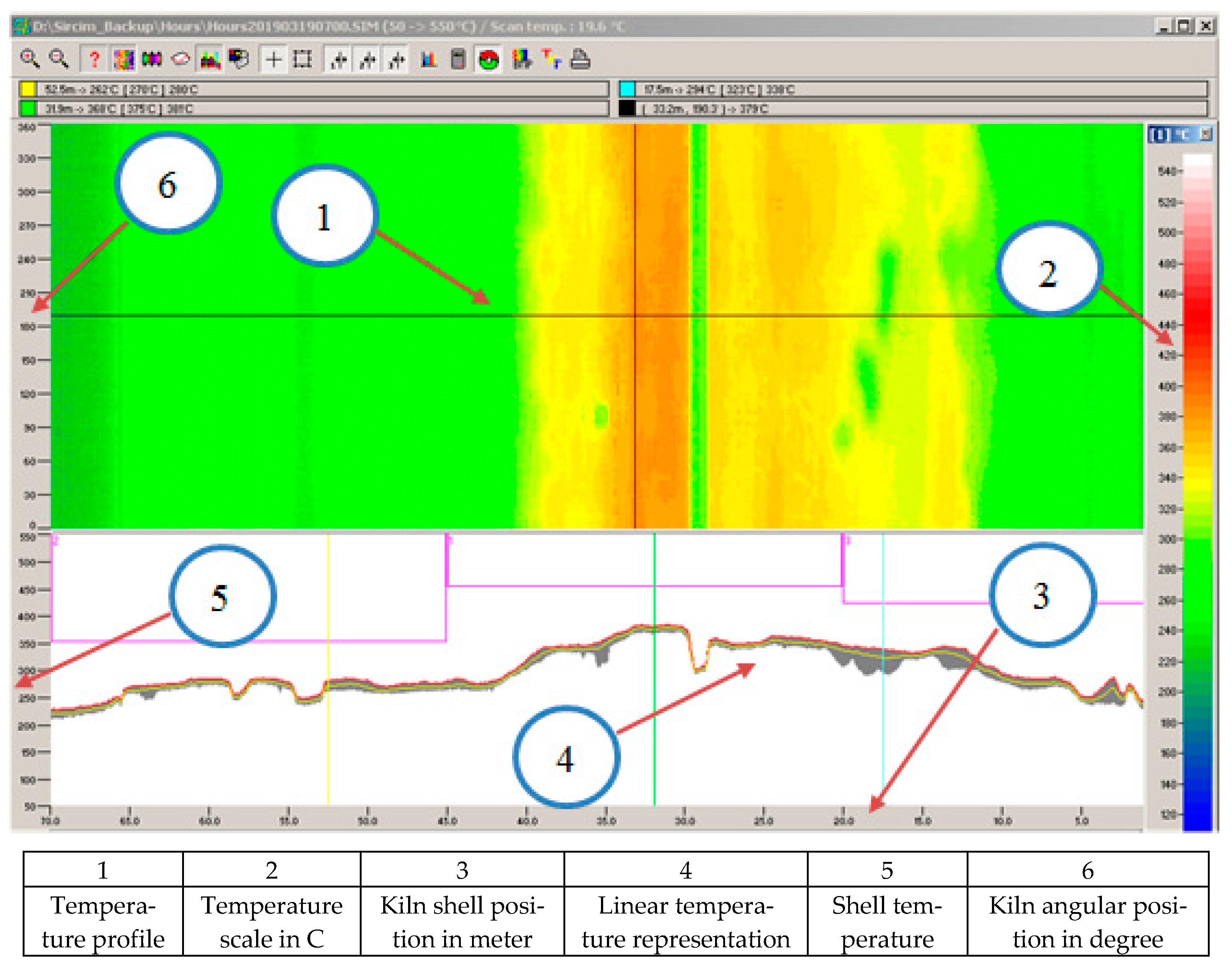
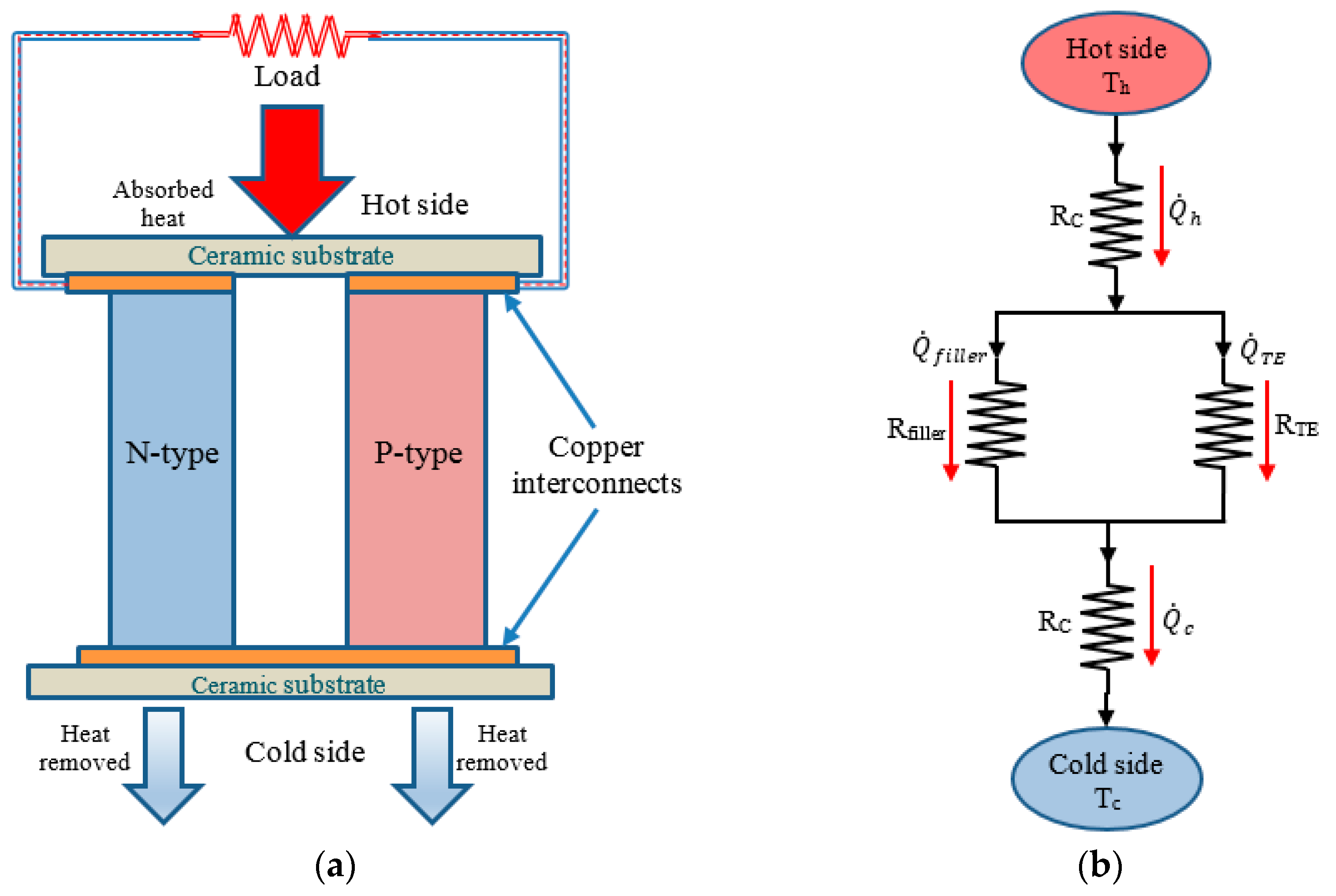
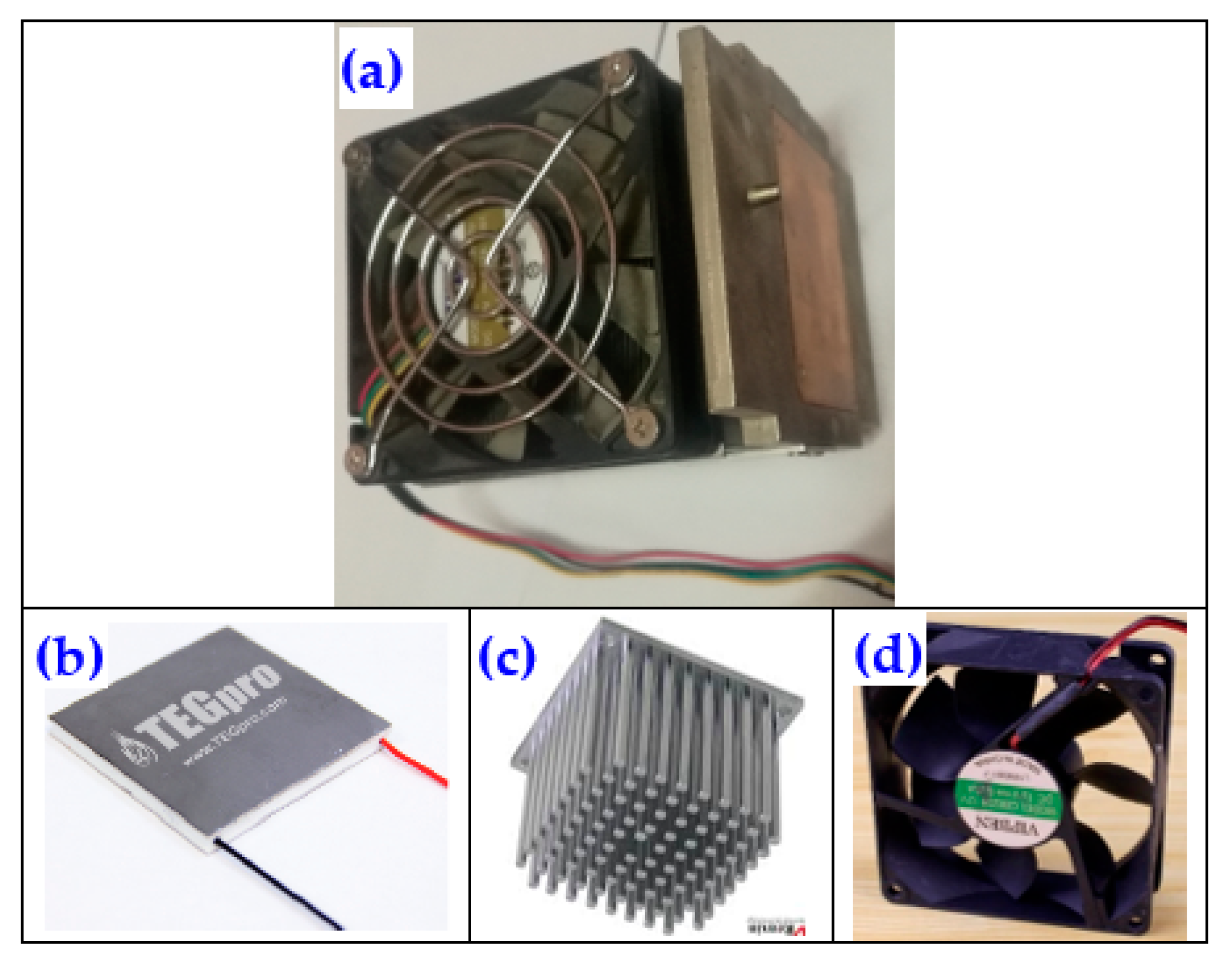

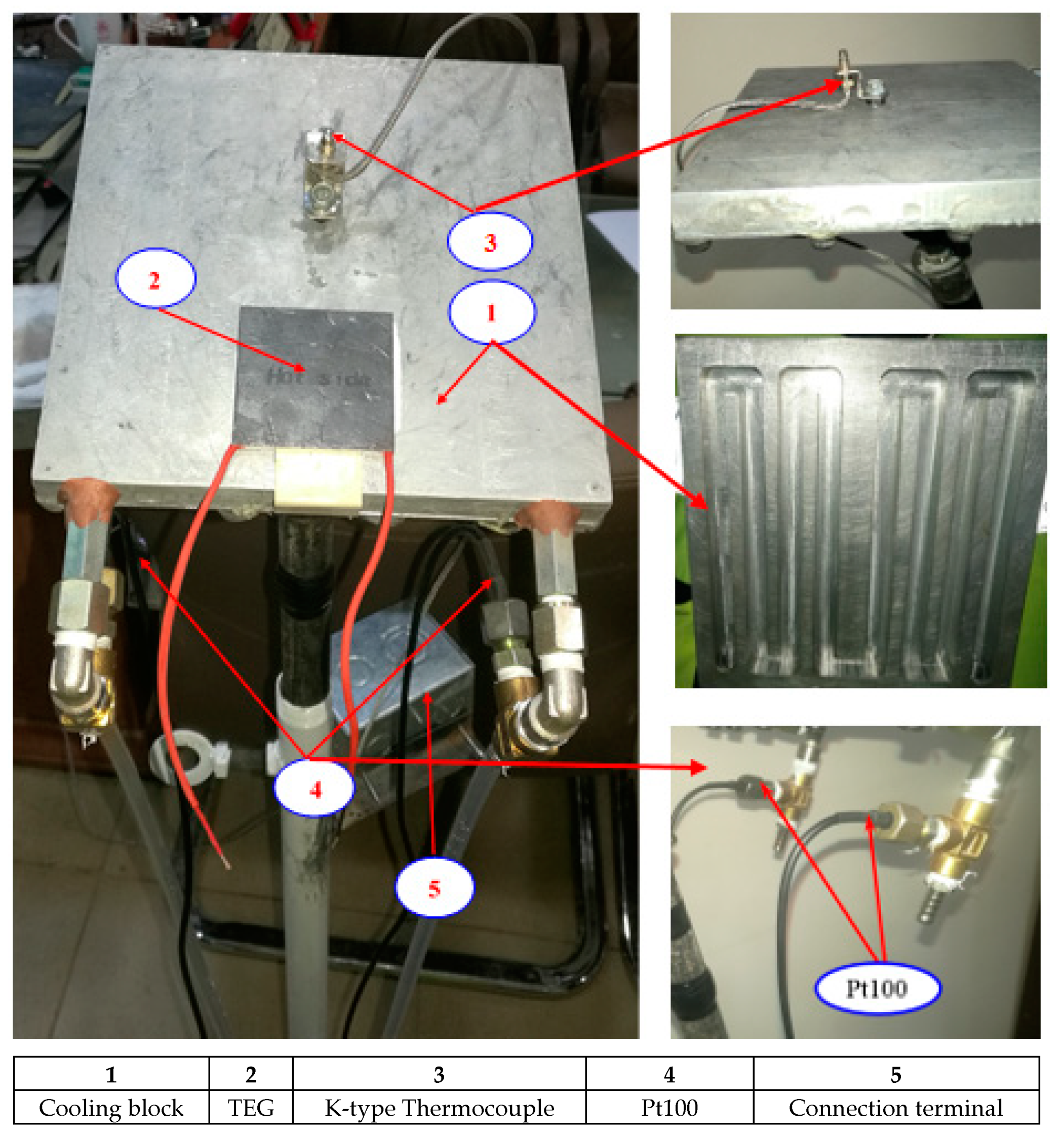


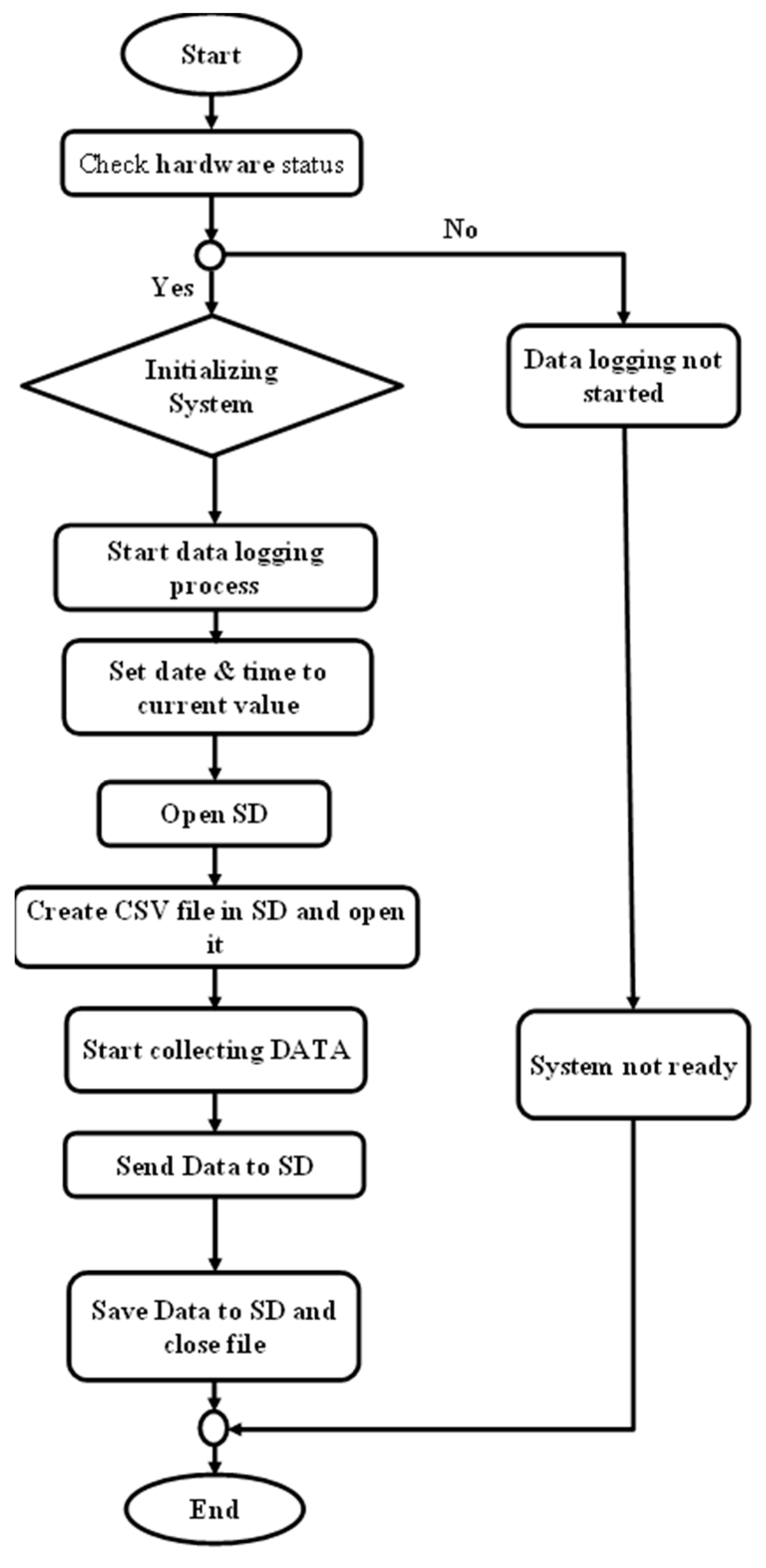
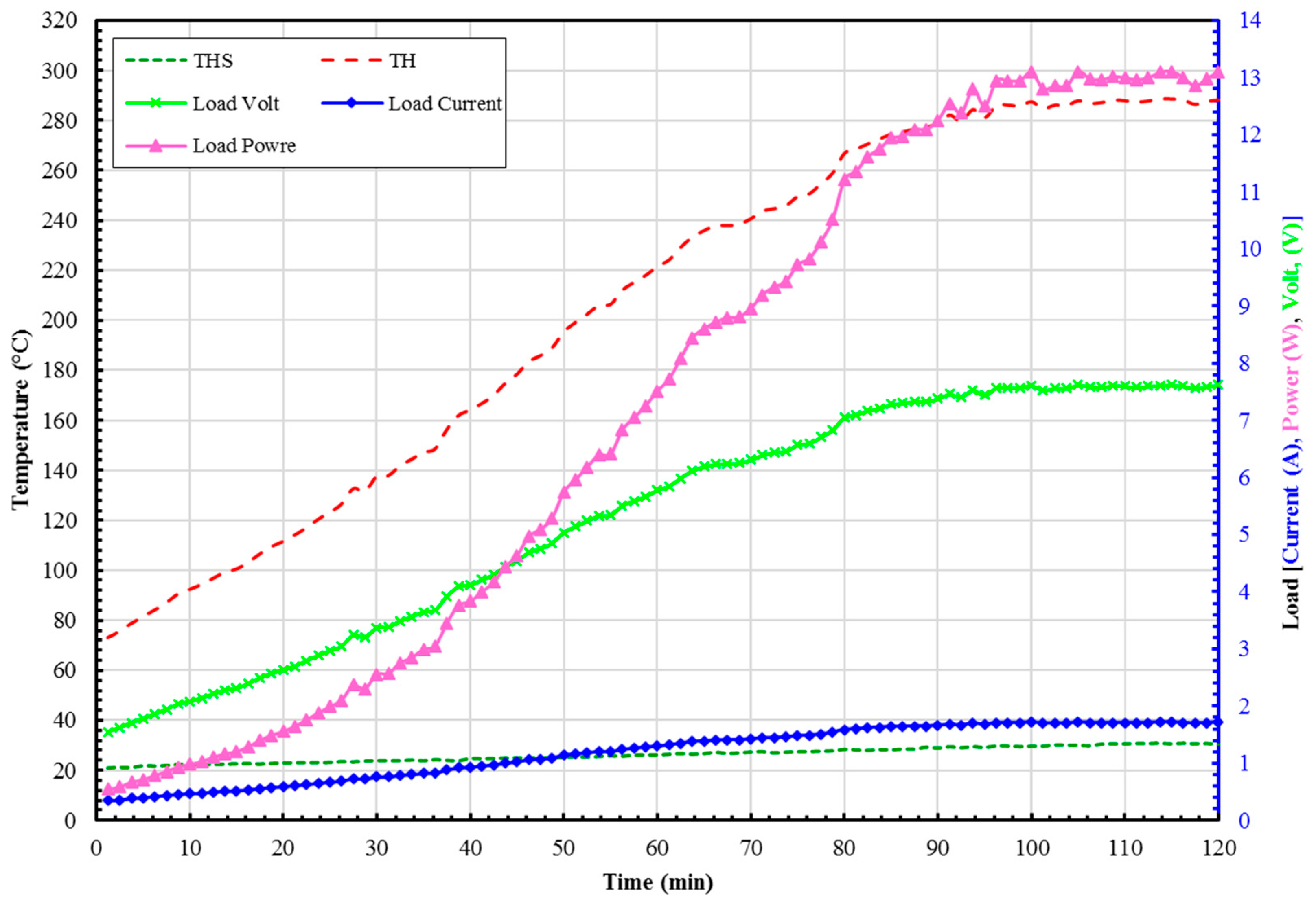

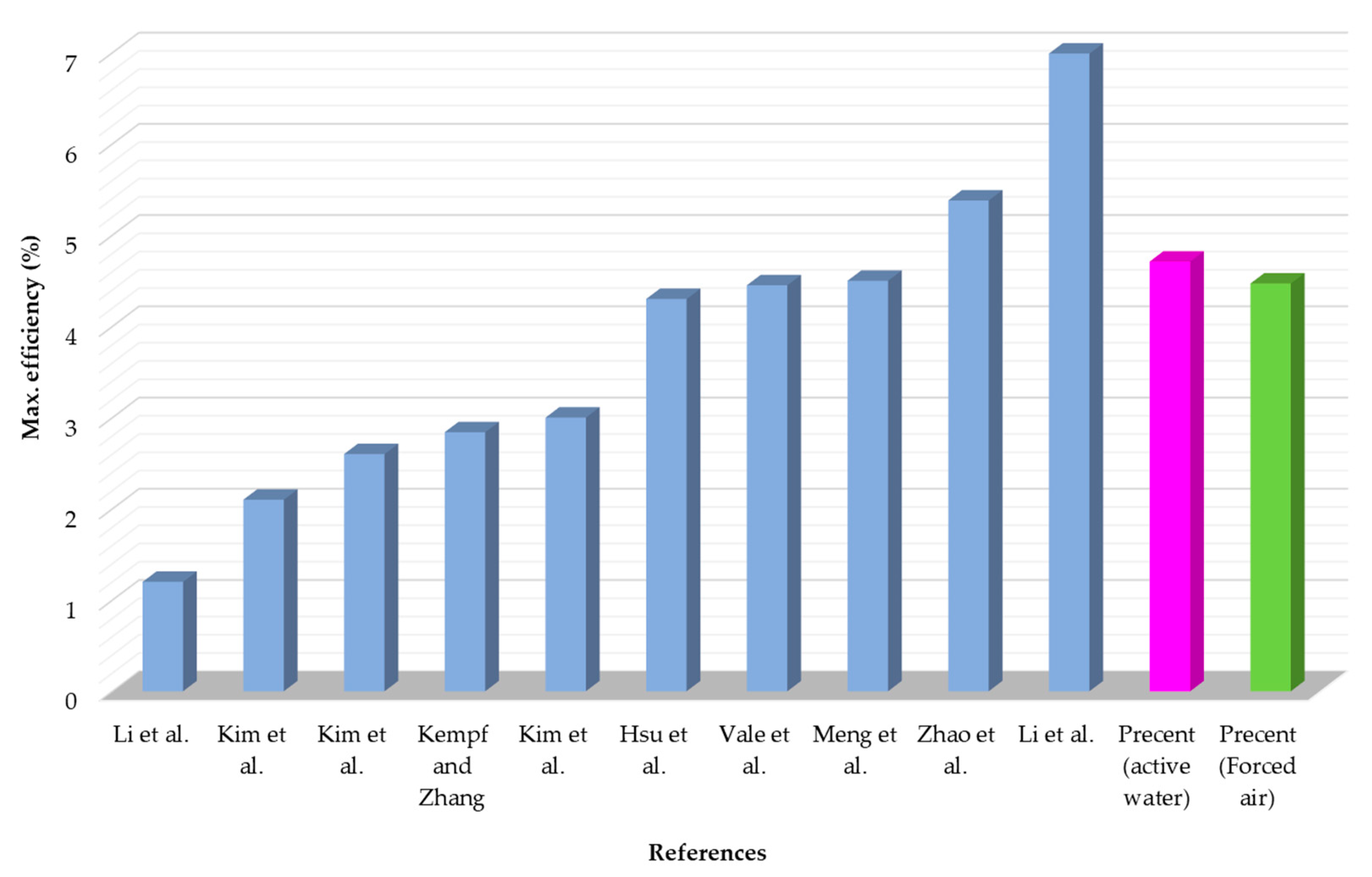
| Kiln Shell Segment Position, (m) | Temp., (°C) | Emissivity, ε (-) | Wind Speed (m/s) | αtot (W/m2·°C) | (kW) | |
|---|---|---|---|---|---|---|
| From | To | |||||
| 30 | 31 | 377 | 0.9 | 2.4 | 33.4821 | 167.5631 |
| 31 | 32 | 384 | 0.9 | 2.4 | 34.12683 | 174.1668 |
| 32 | 33 | 383 | 0.9 | 2.4 | 34.03405 | 173.2122 |
| 33 | 34 | 378 | 0.9 | 2.4 | 33.57353 | 168.4953 |
| 34 | 35 | 374 | 0.9 | 2.4 | 33.20911 | 164.7885 |
| Cooling Method | Average Measured Data | Calculated Data | |||||
|---|---|---|---|---|---|---|---|
| Th (°C) | Tc (°C) | Vmax (V) | Imax (A) | Pmax (W) | ηTEG (%) | ||
| Datasheet | 320 | 30.0 | 8.8 | 2 | 17.6 | 301 | 5.85 |
| Closed water with radiator | 288.0 | 31.0 | 7.5 | 1.65 | 12.375 | 262.95 | 4.71 |
| Forced-air cooling (Heatsink) | 284 | 29.0 | 7.4 | 1.6 | 11.84 | 265.03 | 4.47 |
| Parts | Quantity | Unit Price (JD) | Part List for Each Cooling Method | |
|---|---|---|---|---|
| Water Cooling | Air Cooling | |||
| TEG | 1 | 6 | A | A |
| Water Pump | 1 | 5 | A | NA |
| Pipe and fitting and cooling block | 1 | 4 | A | NA |
| Water tank | 1 | 3 | A | NA |
| Finned heatsink | 1 | 3 | NA | A |
| Fan | 2 | NA | A | |
| Radiator | 1 | 2 | A | NA |
| Cost without sensors (JD) | 20 JD (28 $) | 11 JD (15.7 $) | ||
| Cooling Method | Power Generated (W) | Parts Cost (USD) | Watt Price (USD/W) |
|---|---|---|---|
| Cooling water with a radiator | 12.375 | 28 | 2.2 |
| Heatsink | 11.84 | 15.7 | 0.75 |
| Cooling Method | Saving Power (kWh/Year) | Saving Power Cost (USD/Year) | Payback Period (Year:Month) |
|---|---|---|---|
| Cooling water with radiator | 108.40 | 21.36 | 1:4.0 |
| Forced-air cooling | 103.72 | 20.43 | 0:9.2 |
Publisher’s Note: MDPI stays neutral with regard to jurisdictional claims in published maps and institutional affiliations. |
© 2022 by the authors. Licensee MDPI, Basel, Switzerland. This article is an open access article distributed under the terms and conditions of the Creative Commons Attribution (CC BY) license (https://creativecommons.org/licenses/by/4.0/).
Share and Cite
Gomaa, M.R.; Murtadha, T.K.; Abu-jrai, A.; Rezk, H.; Altarawneh, M.A.; Marashli, A. Experimental Investigation on Waste Heat Recovery from a Cement Factory to Enhance Thermoelectric Generation. Sustainability 2022, 14, 10146. https://doi.org/10.3390/su141610146
Gomaa MR, Murtadha TK, Abu-jrai A, Rezk H, Altarawneh MA, Marashli A. Experimental Investigation on Waste Heat Recovery from a Cement Factory to Enhance Thermoelectric Generation. Sustainability. 2022; 14(16):10146. https://doi.org/10.3390/su141610146
Chicago/Turabian StyleGomaa, Mohamed R., Talib K. Murtadha, Ahmad Abu-jrai, Hegazy Rezk, Moath A. Altarawneh, and Abdullah Marashli. 2022. "Experimental Investigation on Waste Heat Recovery from a Cement Factory to Enhance Thermoelectric Generation" Sustainability 14, no. 16: 10146. https://doi.org/10.3390/su141610146
APA StyleGomaa, M. R., Murtadha, T. K., Abu-jrai, A., Rezk, H., Altarawneh, M. A., & Marashli, A. (2022). Experimental Investigation on Waste Heat Recovery from a Cement Factory to Enhance Thermoelectric Generation. Sustainability, 14(16), 10146. https://doi.org/10.3390/su141610146







